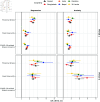The role of financial stress, food insecurity, and COVID-19-related illness concerns shaping mental health in five South Asian countries during the pandemic (2020-2022): A secondary analysis of the online COVID-19 Trends and Impact Survey (CTIS) data
- PMID: 40779535
- PMCID: PMC12334018
- DOI: 10.1371/journal.pgph.0004704
The role of financial stress, food insecurity, and COVID-19-related illness concerns shaping mental health in five South Asian countries during the pandemic (2020-2022): A secondary analysis of the online COVID-19 Trends and Impact Survey (CTIS) data
Abstract
The COVID-19 pandemic has substantially impacted mental health worldwide, yet little attention has been given to its acute and long-term effects on mental health in low- and middle-income countries (LMICs). This study investigates how a triad of pandemic-related worries-financial stress, food insecurity, and COVID-19-related illness concerns-are associated with depression and anxiety across five South Asian LMICs: Bangladesh, India, Nepal, Pakistan, and Sri Lanka. Using data from the COVID-19 Trends and Impact Survey (CTIS), we analyzed responses from over 3.6 million participants collected between June 27, 2020 and June 25, 2022. We employed survey-weighted logistic regression models based on the complete cases (N = 1,062,786), adjusting for demographics and calendar time. Due to a substantial change in the survey design on May 20, 2021, our analysis was divided into two distinct periods: Period 1 (pre-change) and Period 2 (post-change). Our main findings reveal that all three types of pandemic-related worries were significantly associated with increased levels of depression and anxiety across the studied countries. In Period 1, a random-effects meta-analysis showed financial stress had the highest pooled adjusted odds ratio (OR) for depression at 2.41 (95% confidence interval, CI: [2.26, 2.58]), followed by COVID-19-related illness concerns at 1.58 (95% CI: [1.43, 1.75]), and food insecurity at 1.52 (95% CI: [1.40, 1.67]). In Period 2, the pooled adjusted OR for depression increased to 2.74 (95% CI: [2.38, 3.12]) for financial stress, while food insecurity showed a notable rise to 2.42 (95% CI: [2.23, 2.62]). Heterogeneity across countries was substantial ([Formula: see text] ranged from 60.33% to 86.68%), except for the association between food insecurity and depression in Period 2. Country-specific analyses further confirmed these results. Additionally, calendar time, vaccination status, gender, education, and rural-urban residential status modified these associations. These results underscore the need for targeted interventions to address socioeconomic stressors and improve mental health resilience in LMICs.
Copyright: © 2025 Yang et al. This is an open access article distributed under the terms of the Creative Commons Attribution License, which permits unrestricted use, distribution, and reproduction in any medium, provided the original author and source are credited.
Conflict of interest statement
The authors have declared that no competing interests exist.
Figures



Similar articles
-
Physical interventions to interrupt or reduce the spread of respiratory viruses.Cochrane Database Syst Rev. 2023 Jan 30;1(1):CD006207. doi: 10.1002/14651858.CD006207.pub6. Cochrane Database Syst Rev. 2023. PMID: 36715243 Free PMC article.
-
Unconditional cash transfers for reducing poverty and vulnerabilities: effect on use of health services and health outcomes in low- and middle-income countries.Cochrane Database Syst Rev. 2017 Nov 15;11(11):CD011135. doi: 10.1002/14651858.CD011135.pub2. Cochrane Database Syst Rev. 2017. Update in: Cochrane Database Syst Rev. 2022 Mar 29;3:CD011135. doi: 10.1002/14651858.CD011135.pub3. PMID: 29139110 Free PMC article. Updated.
-
Falls prevention interventions for community-dwelling older adults: systematic review and meta-analysis of benefits, harms, and patient values and preferences.Syst Rev. 2024 Nov 26;13(1):289. doi: 10.1186/s13643-024-02681-3. Syst Rev. 2024. PMID: 39593159 Free PMC article.
-
Psychological therapies for women who experience intimate partner violence.Cochrane Database Syst Rev. 2020 Jul 1;7(7):CD013017. doi: 10.1002/14651858.CD013017.pub2. Cochrane Database Syst Rev. 2020. PMID: 32608505 Free PMC article.
-
Investigation and analysis of mental health status of the older adult in western rural areas.Front Public Health. 2025 Jul 16;13:1612600. doi: 10.3389/fpubh.2025.1612600. eCollection 2025. Front Public Health. 2025. PMID: 40740371 Free PMC article.
References
-
- Tran AG, Lam CK, Legg E. Financial stress, social supports, gender, and anxiety during college: a stress-buffering perspective. Counsel Psychol. 2018;46(7):846–69.
LinkOut - more resources
Full Text Sources
